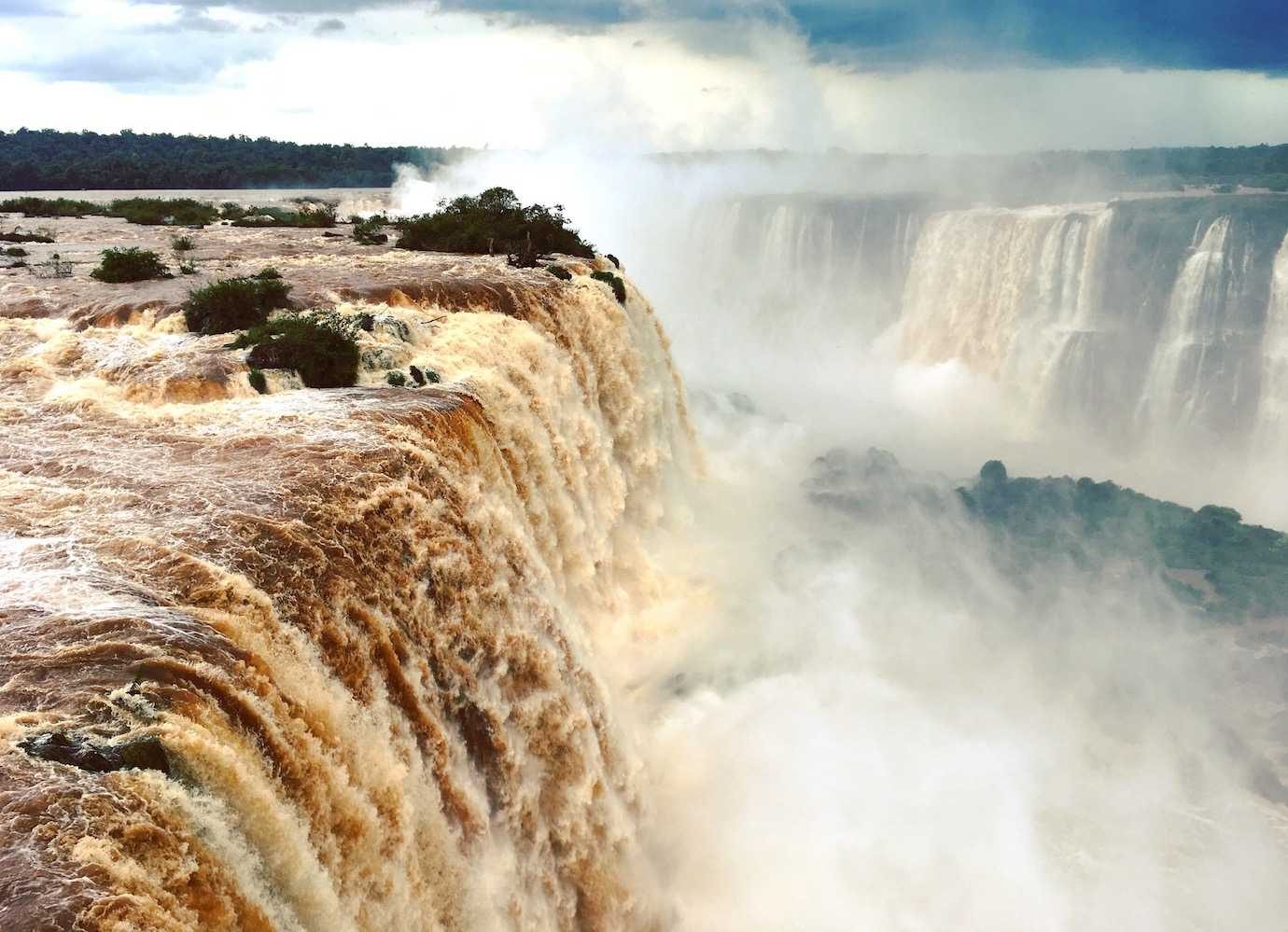
On the border between Brazil and Argentina lies the Iguazu Falls, one of the seven natural wonders of the world. Almost twice as tall and wide as Niagara Falls, the Iguazu Falls are an incredible force of nature – 1.7 miles long featuring 275 waterfalls up to 80 metres tall and flowing up to 5000 cubic metres per second. In other words, jaw dropping!
A bucket list experience for sure, no visit to Brazil nor Argentina is viewed as complete without a visit to these incredible falls. My friend and I visited the Iguazu Falls on the last leg of our 10 week South American trip and they didn’t disappoint!
They were our first port of call on crossing the border and arriving to Brazil. With Brazil and Argentina both home to the Iguazu Falls, many people are torn over which side to visit: Brazilian or Argentinean. We were able to visit both sides so read on for a breakdown of what to expect from each side, my thoughts on which side to visit and some tips.
First up – The Brazilian side
The Brazilian side is the side to visit if you’re after sweeping panoramic views of the Iguazu Falls from a distance. The park is open from 9am to 5pm and expect to pay around R$60.
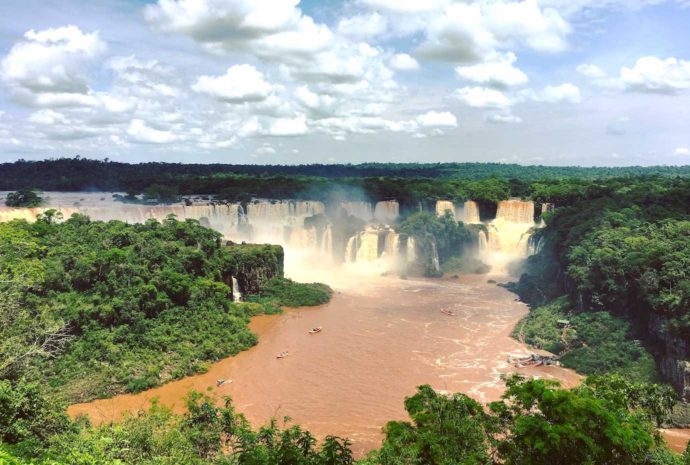
After buying tickets at the entrance, you’ll join the queue for the buses that drop you off at the start of the trail to the falls. Along the bus route, there are several stops for additional optional activities which aren’t included in the ticket price.
The main trail has several viewpoint stops offering panoramic views of the falls and at the end of the trail you can walk along the footbridge to the base of the Devil’s Throat. I’m giving you a heads up now: you will get soaked! I completely underestimated how wet I’d get and had my phone out taking pictures.

It was all well and good until later, when I came to charge my phone at the hostel. On 8% it refused to charge and going out for dinner was quickly put on hold with me panicking about my phone, not only because it was my phone but it was also my camera for the trip. Rushing to the supermarket, we bought some rice and I buried my phone in rice for a few hours. Of course nothing is ever simple and when I came to check if it would charge later, the charger refused to enter my phone’s port because amazingly a tiny grain of rice had got lodged in it. Ten tense minutes later and we had removed the grain and thankfully my phone was charging normally. Crisis averted!
So long story short, be careful with how wet your phone or camera gets. It’s a good idea to have a plastic case or bag to protect it from the water.
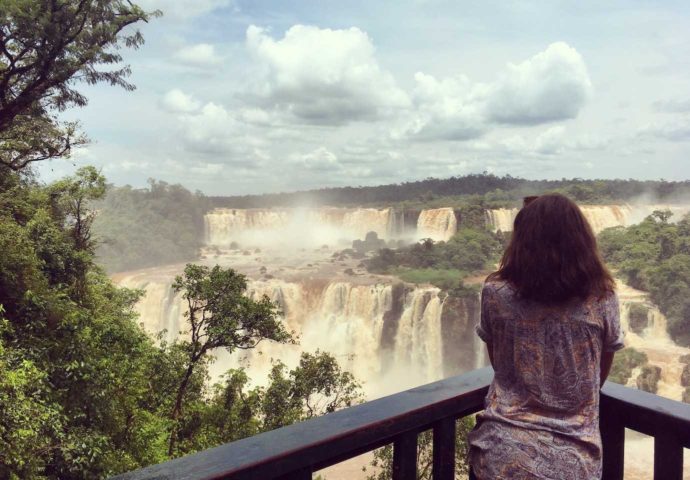
After a few hours at the fall and lunch (it was all the time we needed even taking our time), we headed to the bird park, Parque Das Aves, opposite the Iguazu Falls National Park. It was more fun than I was expecting with lots of colourful birds wandering around and the chance to get up close to some toucans.
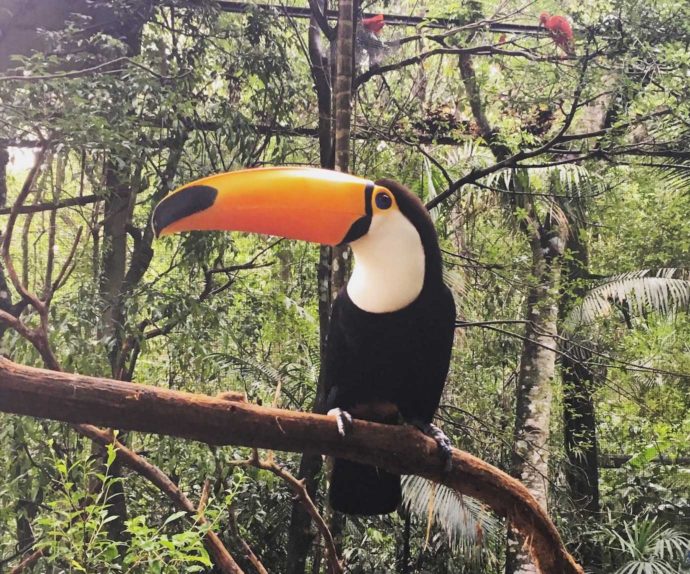

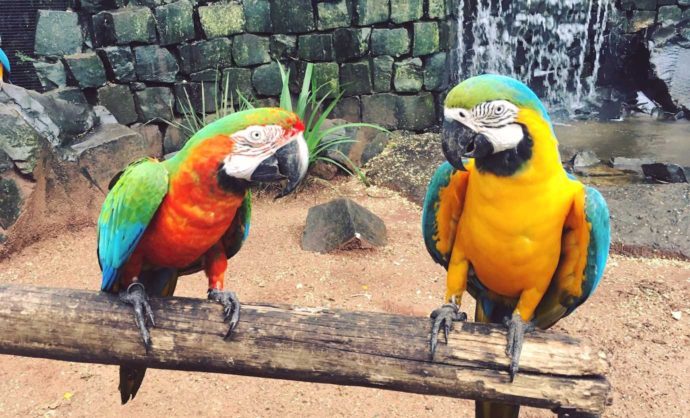
Second up – the Argentinean side
The Argentinean side is the side to visit if you want to get a real up close feel for the falls. The park is open from 8am to 6pm. Because we booked our visit with a guide, I’m not sure how much a ticket costs – I’ve read it’s around 500 Argentinean pesos. You can also get a 50% discount off tickets if you return for a second day.
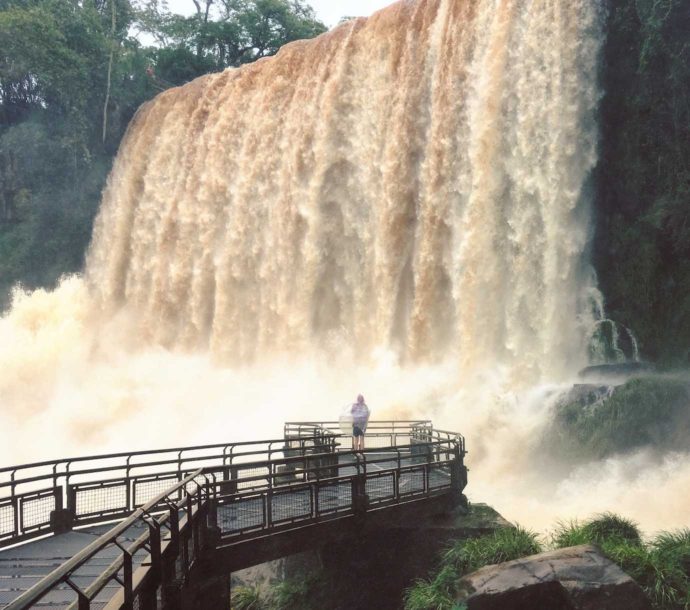
To visit the Argentinean side we signed up with a guide at our hostel. You can do it yourself on public transport, but since we were staying on the Brazilian side we decided to go with a guide to cut travel times.
We were picked up from our hotel and driven to the Argentinean side crossing the border where our passports were checked. It was a wet wet morning; wearing my raincoat and poncho we hopped on the jungle train to the Devil’s Throat station from where it’s a short walk to the most popular highlight of the falls: the impressive Devil’s Throat (La Garganta del Diablo).
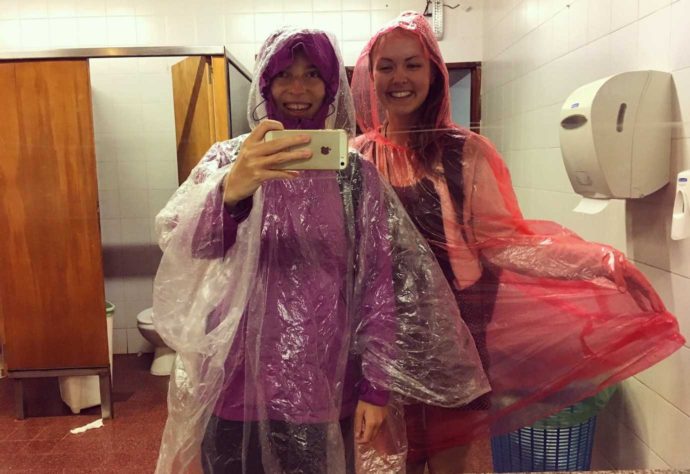
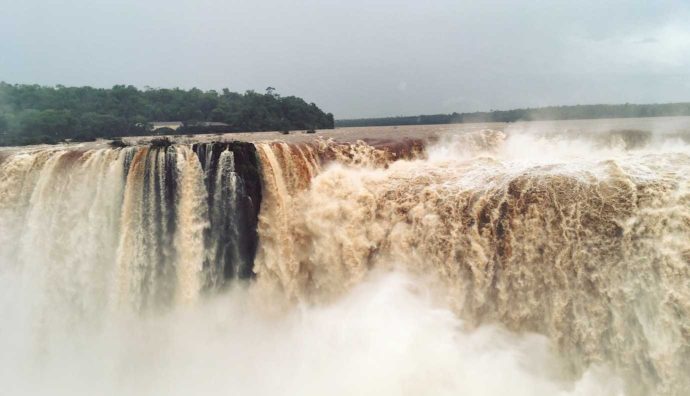
The viewing platform gets you really close to the roaring and thundering waterfall so be prepared to get wet and slightly battered. In our case, we were already soaked so what was a bit more water! Following my wet phone incident the previous day, I was taking no chances and keeping my phone well protected from the water.

We then caught the train back down to the Falls station where the Upper and Lower circuit trails start. We did the Upper circuit trail first which crosses the top of the falls and lets you look down over the edges of the falls. It was bizarre to go from seeing the falls at a distance to standing on top of them watching the water rushing down. After a pause for lunch, we explored the Lower circuit getting up close to the base of a few waterfalls.
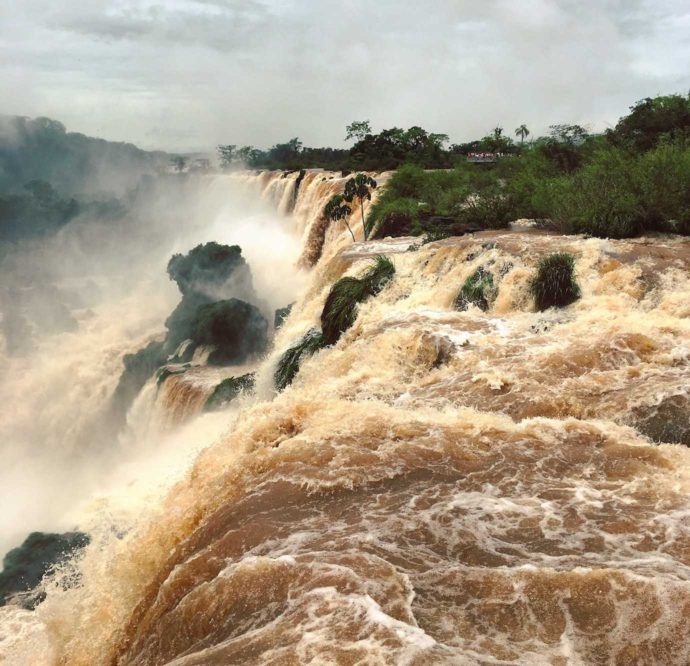
The Upper Circuit
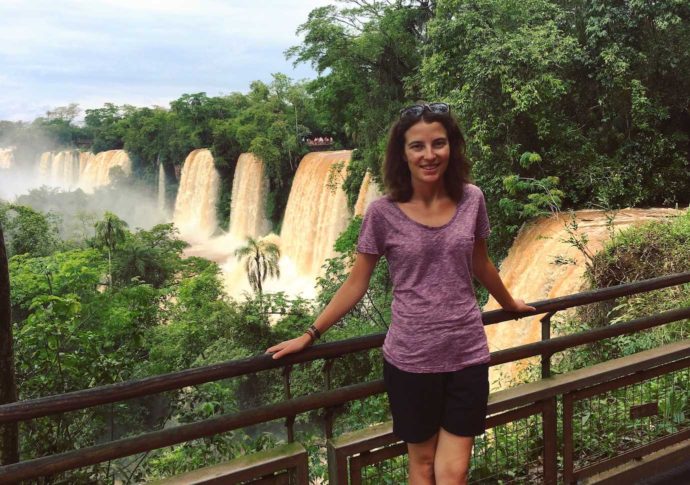
The Lower Circuit
We had planned to go on a boat ride to the base of the falls. However, due to the rainfall and the river, all boat trips were cancelled which was sad. I would have loved to have gone on one, but hey that’s life!
On our way back to Brazil, we briefly stopped off at the three borders landmark for Argentina, Brazil and Paraguay. It was cool to see how close the three countries are, just separated by the Parana and Iguazu rivers joining.
5 Tips for visiting the Iguazu Falls
#1 Half a day is all you need for Brazil, you’ll need a whole day for Argentina
On the Brazilian side there is one short walkway offering panoramic vistas of the entire falls, half a day is an ample amount of time to spend there. You can always extend your visit with a few activities the park offers or a helicopter flight over the falls.
The Argentinean side has a lot more circuits and trails, so I’d give yourself a full day there. You can also return the following day for 50% discounted entry provided you validate your ticket on exit.
#2 You’re going to get wet, take a poncho
Getting up close to the waterfalls means you’re going to get wet, especially on the Argentinean side. That said, even on the Brazilian side, which further from the falls, you’ll get soaked walking towards the base of the Devil’s Throat.
I chose to embrace the spray and water during our visit to the Brazilian side and seriously underestimated just how wet I’d get. Do take a poncho or waterproof with you. You can purchase them in the park itself but like most things they’re more expensive, I’d get one beforehand.
You might also want to have a plastic wallet or bag for your phone to protect it from the water and spray.
#3 Be cautious of the coatis
Coatis are everywhere at the falls. Members of the raccoon family, they’re quite cute looking creatures. Don’t let this fool you, they’re also pests and, lacking any fear of humans, will undoubtedly try to steal your food. We were chased by a determined one during one of our lunches.
They do bite and signs are up around the park saying not to feed them so please don’t encourage them by feeding them.
#4 Think about taking your own lunch
Food and drink in the park is expensive. If on a budget like us, I’d recommend bringing your own supplies.
#5 Remember your passport if crossing the border
It’s easy to forget that to visit the other side of the falls you first need to cross a border and enter a different country. Remember your passport for the border crossing.
How to get to the Iguazu Falls
You can reach the Iguazu Falls from both Brazil and Argentina. Foz do Iguaçu is the Brazilian base for visiting the falls and Puerto Iguazu is Argentina’s. Flying to both cities is the quickest way to get there, although flights aren’t always cheap. From Rio, there is usually a stopover in Sao Paulo and from Buenos Aires you can fly directly.
Buses are also an option, although given the size of both countries they are long journeys. For example, a bus from Buenos Aires takes approximately 18 hours.
Entering via Paraguay
We had a rather lengthy journey. In the space of 24 hours, we’d been in three countries: flying from Rurrenabaque in the Bolivian Amazon to La Paz, La Paz to Santa Cruz, Santa Cruz to Asunción in Paraguay and then finally a night bus to Brazil. It involved our bags being left behind in Santa Cruz at the expense of a Bolivian football team’s kit and a mini scare at 5am over which country we were in.
We were slightly scared that during our night bus ride we had somehow crossed the border illegally into Argentina without realising. It turned out to be a misunderstanding on our part given that the bus was still in Paraguay.
For those travelling from Paraguay, there are two buses you can catch to the Iguazu Falls. One goes to Foz do Iguaçu and the other Ciudad del Este. The Foz do Iguaçu bus was sold out when we arrived to Asunción’s bus station so we booked the Ciudad del Este one thinking for some reason that it would take us to Argentina’s side of the Iguazu Falls.
For the record, this wasn’t the case as it had escaped our notice that Ciudad del Este is Paraguay’s border city. From there, we still needed to get a bus to the Paraguay/Brazil border, hop off for a passport stamp and catch another bus on the Brazilian side. It was such a relief to discover at 5am that our mini scare was for nothing and ultimately everything went smoothly.
Final thoughts on the Iguazu Falls
The Iguazu Falls are an incredible force of nature and definitely worth the visit. When tossing up between the two sides, remember that the Brazilian side shows you the bigger picture offering panoramic views and an overview from a distance; whereas the Argentinean side lets you really get up close to the falls and experience their sheer power.
To get the best from your Iguazu Falls experience, I really recommend not choosing between them. A trip to each side compliments the other as they offer very different perspectives and you only need two days to see both – you won’t regret it! Experiencing both sides shows you the full picture of one of the best natural wonders on our planet.
If visiting both sides, I’d visit the Brazilian side first for the panoramic views and follow up with the Argentinean side the next day for a more close up experience.
If you can only visit one side, then visit Argentina’s side as there is more to see and you can get really close to the falls. If at all possible, try to visit both.
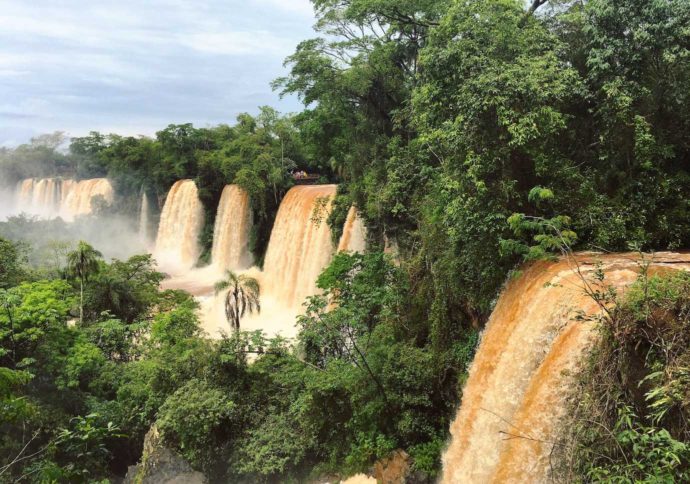
Have you been to the Iguazu Falls? Did you visit both sides or just one?